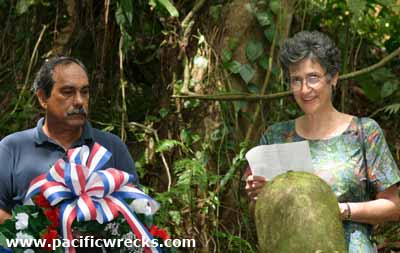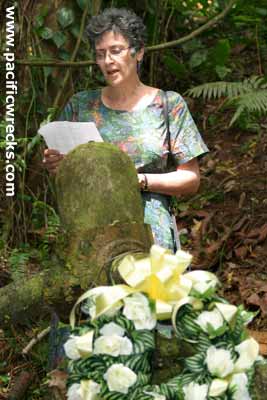60th Anniversary Memorial Ceremony at
Crash Site
February 6, 2005 Thanks to Steven A. Druzak, Deputy Chief of Mission,
U.S. Embassy, Kolonia, Federated States of Micronesia, he coordinated the
event and worked with veterans of VMB-613
Association related to this crash.
On the 60th
anniversary of its crash of of USMC PBJ
35275 February 6, 1945, the United States Embassy in the Federated
States of Micronesia (FSM), the FSM government, and local veterans
joined to commemorate the 60th anniversary of the loss in combat of
a U.S. Marine Corps bomber. On February 6, 1945, a flight of six PBJ-1
bombers from U.S. Marine Bombing Squadron (VMB) 613 struck the newly
completed Japanese airfield at Palikir on the island of Pohnpei in
the Caroline Islands. Although the target suffered heavy damage, one
aircraft was shot down with the loss of all on board. At 1115 am on
February 6, 2005, the same time that Japanese anti-aircraft fire brought
down the aircraft, the names of the crew members who made the supreme
sacrifice during the raid were read, taps was sounded, and Ambassador
Suzanne Hale and Speaker of the FSM Congress Peter Christian placed
a wreath on the aircraft’s
engine and propeller, which still rest at the crash site.
 |
 |
Over
thirty people took part in the ceremony, held in a jungle clearing on
a hillside above the old airfield site at Palikir in northern Pohnpei.
Attendees included Department of Foreign Affairs Assistant Secretary
for American and European Affairs Jane Chigiyal, World War II veteran
Harvey Segal, now a professor at the College of Micronesia and Vietnam
Veteran Frank Semens, U.S. Army, Retired, as well as Marine Corps veterans
Anthony Mix and Petericko Jacob.
VMB-613 was the only Marine Corps squadron
to fly the PBJ-1H in combat. This aircraft was notable for carrying
a 75 mm cannon in addition to bombs and machine guns. The six aircraft
involved in the raid flew from the squadron’s forward operating base on Eniwetok Atoll. Defying
bad weather and intense anti-aircraft fire, the flight cratered the runway
and demolished a large building adjacent to the field with a 75 mm. round.
However, the last aircraft in the formation, piloted by Lt. William J.
Love, was hit as it leveled out for its bombing run. The plane’s
right wing collapsed and the bomber crashed and exploded. The crew’s
remains were recovered after the war and returned to the U.S. for burial.
The navigator on another aircraft in the formation was also killed during
the attack. The abandoned Japanese air base was transformed into the
site of the FSM national capital during the late 1980s.
|